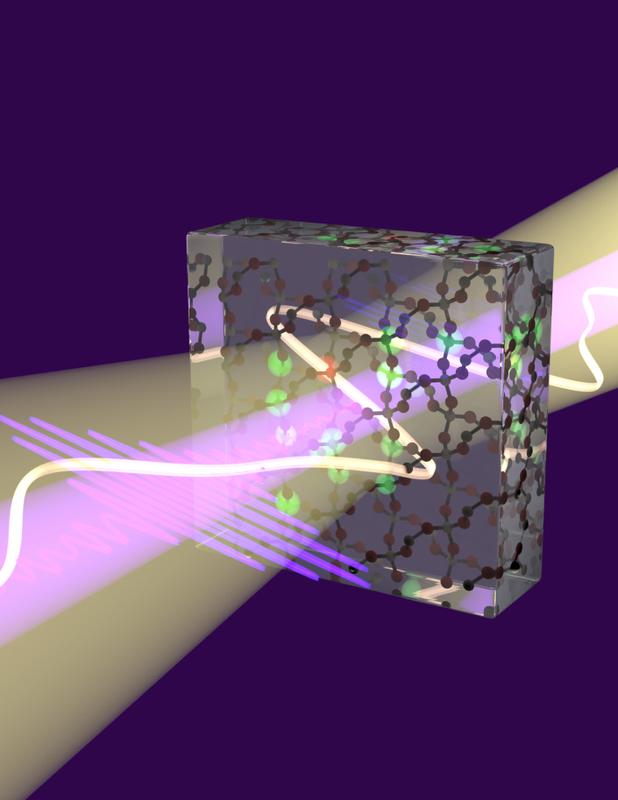Ultrafast snapshots of relaxing electrons in solids

Attosecond flashes of light and x-rays take snapshots of fleeting electrons in solids. Graphic: MPQ, Attoelectronics Group
When x-rays shine onto solid materials or large molecules, an electron is pushed away from its original place near the nucleus of the atom, leaving a hole behind. For a long time, scientists have suspected that the liberated electron and the positively charged hole form a new kind of quasiparticle — known as ‘core-exciton’.
But so far, there has not yet been a real proof of its existence. Scientists have a wide range of tools to track excitons in semiconductors in real-time. Those are generated by ordinary light, and can be employed in various applications in optoelectronics and microelectronics. On the contrary, core-excitons are extremely short-lived, and up to now, no technique was available to track their motion and deduce their properties.
A team of scientists led by Dr. Eleftherios Goulielmakis, head of the research group “Attoelectronics” at the Max Planck Institute of Quantum Optics, have been able to capture the dynamics of core-excitons in solids in real-time. Using flashes of x-ray radiation lasting only few hundred attoseconds (1 attosecond = 0.000000000000000001 seconds) followed by optical light flashes of similar duration (a tool developed by the group last year) the scientists obtain an ultrafast camera which allowed them to take snapshots of the short-lived excitons in silicon dioxide for the first time. The work is published in this week’s issue of the Science magazine (DOI:10.1126/science.aan4737).
“Core-excitons live for a very short time because their interactions with other particles in the solid quickly stops their motion,” said Antoine Moulet, leading author in this work. “In quantum mechanics we say that the exciton loses its coherence,” he adds.
A key tool to track the dynamics of core-excitons has been the development of attosecond light flashes in the optical range. The work was published by the Attoelectronics group last year.
“In our experiment we use x-ray flashes to light up core-excitons in solids, whereas the optical attosecond pulses provide the possibility to resolve this motion in real-time,” says Julien Bertrand, a former researcher in the group of Goulielmakis, at present assistant professor at Laval University, Canada. “The combination of both allowed us to take snapshots of the motion of core-excitons which lived for approximately 750 attoseconds.”
But the study was not limited to capturing these fleeting motions inside solids. “We were able to acquire quantitative information about the properties of core-excitons such as their miniature dimension which were merely bigger than that of a single atom, or how easily they are polarized by visible light,” says Goulielmakis. “Our technique advances excitonics, i.e. the measurement, the control and the application of excitons in the x-ray regime. But at the same time, it is a general tool for studying ultrafast x-ray initiated processes in solids on their natural time scales. Such a capability has never before been possible in x-ray science.”
The team now envisages applications of their technique for studying ultrafast processes at interfaces of solids, and new routes to realize ultrafast switches for x-ray radiation based on optical light fields. “With x-ray free electron lasers rapidly proliferating around the world, the capability of controlling x-rays with visible light becomes increasingly important,” says Goulielmakis. [EG/OM]
Original publication:
A. Moulet, J.B. Bertrand, T. Klostermann, A. Guggenmos, N. Karpowicz & E. Goulielmakis
Soft x-ray excitonics
Science, 15 September 2017, DOI: 10.1126/science.aan4737
Contact:
Dr. Eleftherios Goulielmakis
ERC Research Group Attoelectronics
Max Planck Institute of Quantum Optics
Laboratory for Attosecond Physics
Hans-Kopfermann-Str. 1, 85748 Garching, Germany
Phone: +49 (0)89 / 32 905 – 632
E-mail: Eleftherios.Goulielmakis@mpq.mpg.de
Dr. Olivia Meyer-Streng
Press & Public Relations
Max Planck Institute of Quantum Optics, Garching, Germany
Phone: +49 (0)89 / 32 905 – 213
E-mail: olivia.meyer-streng@mpq.mpg.de
Media Contact
More Information:
http://www.mpq.mpg.de/All latest news from the category: Physics and Astronomy
This area deals with the fundamental laws and building blocks of nature and how they interact, the properties and the behavior of matter, and research into space and time and their structures.
innovations-report provides in-depth reports and articles on subjects such as astrophysics, laser technologies, nuclear, quantum, particle and solid-state physics, nanotechnologies, planetary research and findings (Mars, Venus) and developments related to the Hubble Telescope.
Newest articles

A ‘language’ for ML models to predict nanopore properties
A large number of 2D materials like graphene can have nanopores – small holes formed by missing atoms through which foreign substances can pass. The properties of these nanopores dictate many…

Clinically validated, wearable ultrasound patch
… for continuous blood pressure monitoring. A team of researchers at the University of California San Diego has developed a new and improved wearable ultrasound patch for continuous and noninvasive…

A new puzzle piece for string theory research
Dr. Ksenia Fedosova from the Cluster of Excellence Mathematics Münster, along with an international research team, has proven a conjecture in string theory that physicists had proposed regarding certain equations….



